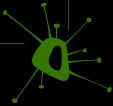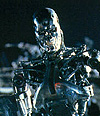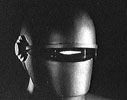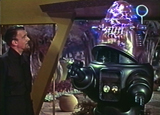
Promise of Science: Robots

<< previous theme (computers) | next theme (man-made life) >>
|
As a theme in science fiction film, robots have taken many forms and served many purposes. They have appeared both as man's servants and man's oppressors. They can be good or evil, often depending on the disposition of their masters. In some cases, they grow beyond the control of their creator and command or destroy human life.
Robots are often made in the image of man. This can be for several reasons, such as making humans comfortable with the robots, allowing the robots to move freely among humans, or simply to satisfy the ego of a robot's creator. They appeared in film long before the development of the technology capable of creating them, and are often technological wonders whose capabilities are extraordinary. | |||
|
The predecessors to robots were mechanical men, which appeared in some of the earliest one-reel films. In The Mechanical Statue and the Ingenious Servant (1907), an engineer creates an automaton that goes out of control and has to be destroyed. This film is reminiscent of Mary Shelley's Frankenstein, as the creation is a creation of science that violates the laws of nature. |
|||
|
|||
|
The robots in THX-1138 (1970, US) are also made in the image of man. Instead of imitating a single human, they are built to resemble police men. There are hundreds of them in this film, and they all look and act the same. Their appearance is fitting since they are the physical enforcers of the oppressive rules of a future post-apocalyptic society. These machines have a very limited scope, and do not appear to be able to think for themselves. They are stupid and clumsy, and are therefore easily thwarted by humans seeking to escape from this society. |
|||
|
|||
|
|||
|
|||
|
Star Wars (1977, US) features both friendly and hostile robots. Two of the lead characters are robot companions of the film's humans. Instead of serving as slaves or servants, they work with people in the film to achieve their goals. Numerous other robots are encountered in this film in a variety of situations serving many different functions. Some are enslaved, some are intelligent, and some are simple, serving single functions. Almost all of them are associated with human or alien leaders, and sometimes can be bought or traded in markets. |
|||
Robots tend to be created by a superior intelligence as servants or assistants to perform manual labor or other tasks that are beyond the capabilities of their creators. Varying amounts of intelligence and power are transferred to these creations, depending on what their intended use is. When improperly implemented, robots can evolve past their original programming, causing conflict with their masters. Safeguards can be put in place, such as those imposed on Robby, but this sort of device is rarely seen. Robots continue to be a favorite theme in science fiction film, both as characters and sources of conflict. |
<< previous theme (computers) | next theme (man-made life) >>
![]()
Further Resources
(See also the complete references and resources list.)
- Dick, Philip K. "Man, Android, and Machine," Science Fiction at Large, edited by Peter Nicholls.. New York: Harper & Row (1976)
- Hurt, Matthew. Cybercinema.: University of Illinois Department of English
http://www.english.uiuc.edu/cybercinema/ (date accessed: 7/1/99) - Kantrowitz, Mark. Milestones in the Development of Artificial Intelligence. (September, 1994)
ftp://ftp.cs.cmu.edu:/user/ai/pubs/faqs/ai/timeline.txt (date accessed: 7/1/99)


. last modified: Jul 20, 2000 .



